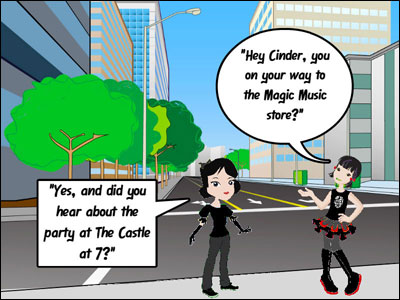
Students learn about key elements of a fairy tale such as setting, characters, problems, and resolution as well as themes like magic, threes and sevens, fairies, forests, royalty, and castles as they retell and recreate a fairy tale in modern times.

The land of fairy tales is filled with beasts and beauty. It is a land where a kiss from a princess can turn a frog into a prince. It is also a land where few dare to venture because of the fearsome challenges that lay ahead.
While younger children dream of being knights and princesses, older students no longer find fairy tales exciting. Your task is to modernize one of these stories so that it has meaning to today’s students. You can even add yourself to the story!
Read a fairy tale to your students, like Hansel and Gretel. Discuss the key elements of the story, such as setting, characters, problems and solutions.
Ask students to share names of other fairy tales they have read. Most students will be familiar with stories like Cinderella, Rapunzel, and Sleeping Beauty. Have students work together to identify common elements between the stories. You might find commonalities like princes and princesses, forests or woods, threes and sevens, and magic.
Many of the most common fairy tales date from long ago. Talk with your students about the fairy tale you read to them. Create a Venn diagram or open one on your computer and project it for students to see. Label the circles Past and Present.

Brainstorm a list of objects or things in the story, like the location, homes, food, clothing, and other objects and add them to the past circle. As they start to identify things specific to the past, ask them questions like:
As a class, discuss how things are different now. For example, few students live deep in the woods, or are allowed to walk long distances by themselves. To prepare students to modernize their own story, ask them questions like:
Tell students that they are going to modernize a fairy tale. You may want to provide a list of examples and share print versions at a variety of reading levels.
Once students have chosen a fairy tale, have them read it and create a list of characters, setting, and plot. Have them complete their own Past and Present Venn Diagram, starting with a list of objects or things that are from the past, to help them come up with specific ideas for making their tale more modern. You might also want them to create a list of character traits for the main character and villain as well as complete a plot diagram.
Using the ideas on their Venn diagrams, have students sketch out the character, setting, and plot for their modern version. Have them share their ideas with a peer and make changes and additions. Then, have students work on writing the story. To simplify, ask students to write a single paragraph for beginning, middle, and end. To expand or extend the project, have students practice descriptive writing or add conversation to practice conversational grammar.
Have students translate their written story into a visual map or project storyboard. This will help them determine how best to convey the story using individual pages or scenes.
Students should add text and conversations to individual pages, or scenes, in their project. They can use paint tools and clip art to illustrate characters, setting, and action. They can use a web cam or even blue screen to capture their picture to add to the modernized version of the story. Have students practice reading the story and then record narration for each page.
Have the students present their stories to the rest of the class. You might also consider inviting the school librarian or media specialist to help evaluate the final products. They may be interested in posting student work to a station in the school’s media center or eBook library.
Share the stories and animations on your school web site, during morning announcements, or in your school or community library. You may also be able to share them on your local access television station as a celebration of student learning. You could even turn this project into a parent night or community storytelling event!
You can use the students’ character/plot/setting, Venn diagrams, character traits, and/or plot diagrams to evaluate comprehension and help students work through misconceptions before the modern version is written. Their modern character/setting/plot and storyboard will help you determine if they are ready to convert their written story into a video or online story.
The final written fairy tale will help you assess their ability to analyze and compare. You can use their narration as a sample of reading fluency. The final illustrated and narrated fairy tale will help you assess their ability to tell a story using multimedia elements.
Mills, Alice. The Random House Children’s Treasury: Fairy Tales, Nursery Rhymes & Nonsense Verse. New York, New York: Gramercy Books, February 1, 1999.
Ponsot, Marie and Segur Adrienne. The Golden Book of Fairy Tales (Golden Classics). New York, New York: Golden Books, October 1, 1999.
Community Learning Network - Fairy Tale Resources www.cln.org/themes/fairytales.html
Collected Fairy Tales by Hans Christian Andersen hca.gilead.org.il
Reading Theme
Craft and Structure
4. Interpret words and phrases as they are used in a text, including determining technical, connotative, and figurative meanings, and analyze how specific word choices shape meaning or tone.
6. Assess how point of view or purpose shapes the content and style of a text.
Writing Theme
Production and Distribution of Writing
4. Produce clear and coherent writing in which the development, organization, and style are appropriate to task, purpose, and audience.
Range of Writing
10. Write routinely over extended time frames (time for research, reflection, and revision) and shorter time frames (a single sitting or a day or two) for a range of tasks, purposes, and audiences
Speaking and Listening Theme
Presentation of Knowledge and Ideas
4. Present information, findings, and supporting evidence such that listeners can follow the line of reasoning and the organization, development, and style are appropriate to task, purpose, and audience.
6. Creative Communicator
Students communicate clearly and express themselves creatively for a variety of purposes using the platforms, tools, styles, formats and digital media appropriate to their goals. Students:
a. choose the appropriate platforms and tools for meeting the desired objectives of their creation or communication.
b. create original works or responsibly repurpose or remix digital resources into new creations.
c. communicate complex ideas clearly and effectively by creating or using a variety of digital objects such as visualizations, models or simulations.
d. publish or present content that customizes the message and medium for their intended audiences.

Follow us on Instagram for daily inspiration

Create a thought web, cluster, flowchart, or other graphic organizer for a lesson
Five ideas for creative classroom centers
Creative, digital book reviews
Fun and powerful ideas with animated characters

Wixie
Share your ideas, imagination, and understanding through writing, art, voice, and video.

Rubric Maker
Create custom rubrics for your classroom.

Pics4Learning
A curated, copyright-friendly image library that is safe and free for education.

Wriddle
Write, record, and illustrate a sentence.

Get creative classroom ideas delivered straight to your inbox once a month.
Topics